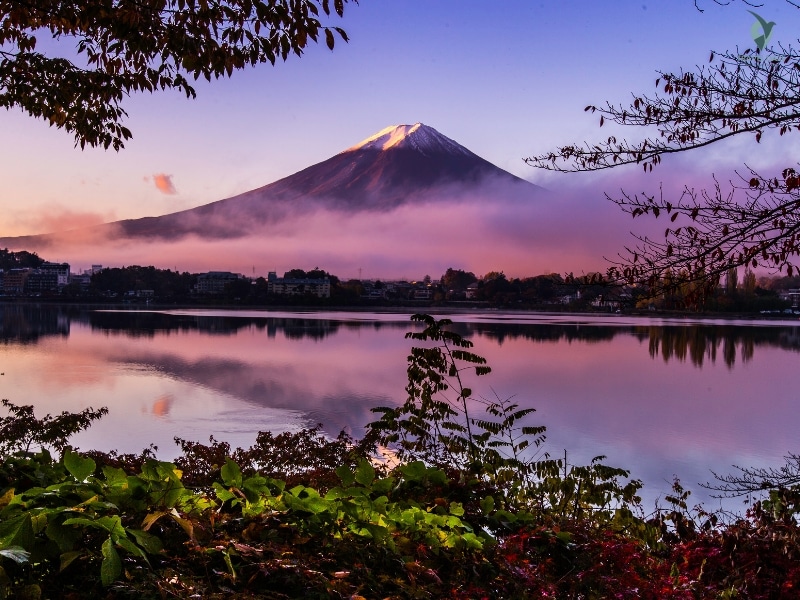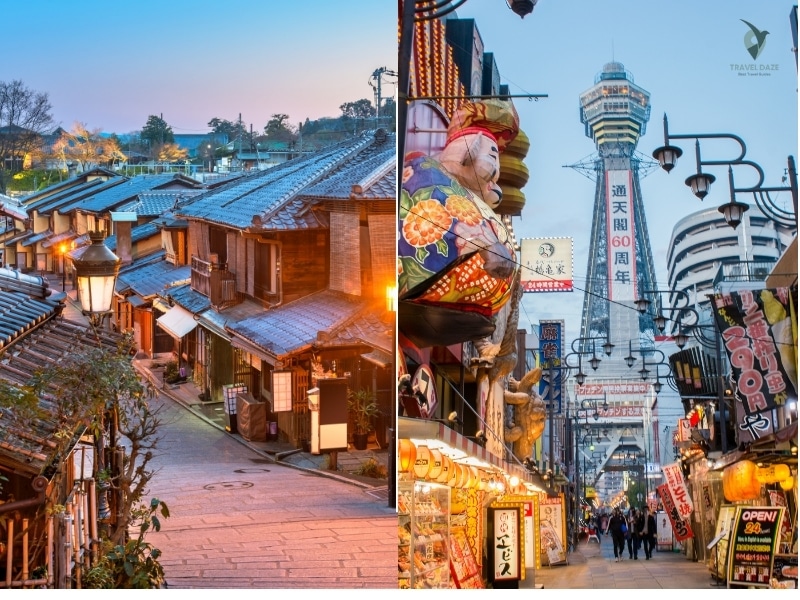Last spring, I was exploring the peaceful streets of Kyoto, away from the busy crowds at Kinkaku-ji and Fushimi Inari. I found a small temple covered in moss, hidden behind a line of traditional wooden houses. The air smelt sweet like cherry blossoms, and all you could hear was the gentle rustling of the leaves. I felt like I had found a hidden world.
Table of Contents
ToggleKyoto is famous for its well-known attractions, but its real charm is found in the hidden gems. These locations provide a stronger link to Japan’s rich cultural heritage. Every place, whether it’s a peaceful temple, a charming railway, or a warm sake brewery, shares its own special story.
What makes these places even more unique is how they transform with the seasons. In spring, cherry blossoms colour the city in shades of pink. In autumn, bright red leaves form a stunning scene. Each visit feels like a fresh experience.
Main Points
- Explore the hidden gems of Kyoto that go beyond the well-known tourist destinations.
- Discover the city’s cultural heritage through peaceful, personal experiences.
- The changing seasons make these hidden places even more beautiful.
- Discover peaceful temples, charming railways, and the local sake tradition.
- Make lasting memories by exploring new and unique places.
Ohara: A Calm Getaway from the Busy Streets
When I got off the bus in Ohara, the peaceful countryside immediately seemed far removed from the busy streets of Kyoto. The journey from Kyoto Station took me through gentle hills and green fields, creating a peaceful atmosphere for my getaway. This place is an ideal getaway for anyone looking for peace and quiet.
Sanzen-in Temple: A Peaceful Place Covered in Moss
My first stop was Sanzen-in Temple, a place that felt like a dream. The temple’s moss gardens were green and lively, making the place feel calm and serene. As I walked through the grounds, away from the city’s hustle, I felt a strong sense of peace.

In autumn, the maple leaves change to a bright red, making the scenery truly beautiful. It’s essential for anyone visiting in the autumn.
Hosen-in Temple: A Mysterious Past
Next, I went to Hosen-in Temple, which is famous for its interesting and memorable history. The ceiling here is made from boards stained with blood from Fushimi Castle, reminding us of Japan’s troubled history. I felt both wonder and seriousness as I discovered its story.
This temple, like Sanzen-in, is particularly lovely in autumn, with its surroundings filled with bright reds and oranges.
Before I left Ohara, I visited a local café to sample their special vegetables. The fresh, seasonal flavours were a wonderful way to finish my day in this calm place.
The Philosopher’s Path: More Than a Stroll
Walking along the Philosopher’s Path, I experienced a peaceful feeling that only Kyoto can provide. This beautiful route, named after the philosopher Nishida Kitaro, runs beside a canal and provides a calm getaway from the busy city. Even though it’s a well-known place, its calming vibe gives it a unique, peaceful feeling.

In spring, the path becomes a beautiful sight with cherry blossoms lining the way in shades of pink. The gentle petals drifting into the water create a beautiful sight. Walking here is like entering a painting, with each step offering a fresh view.
If you want some peace and quiet, early mornings are the perfect time to go. The calm provides a chance for thoughtful reflection, making it an ideal place to engage with Kyoto’s culture and history. This path has something special for everyone, whether you’re a thinker or just exploring.
Honen-in Temple: A Quiet Retreat
Honen-in Temple is a small detour from the main path, and it feels like a hidden gem waiting to be found. The gates covered in moss and the peaceful surroundings give a feeling of seclusion. As I wandered through its grounds, I experienced a profound sense of calm, away from the busy crowds.
The charm of the temple lies in its simplicity. Although it may not be as impressive as some of the other temples in Kyoto, its calm beauty makes a strong impact. It’s a spot where time feels like it stops, encouraging you to take a moment and think.
Otoyo Shrine: Unique Rat Protectors
As I continued down the path, I came across Otoyo Shrine, a small yet interesting place. The unique feature is its rare rat statues that act as guardians. These unique figures are connected to local stories, bringing a fun element to the shrine’s vibe.
Otoyo Shrine may not be one of Kyoto’s main attractions, but it provides a look at the city’s hidden side. It reminds us that even the tiniest places can have important stories to tell. Being here was like discovering a secret treasure in Kyoto.
Sagano Scenic Railway: A Journey Through Nostalgia
As soon as I got on the Sagano Scenic Railway, it felt like I had entered another time period. The “Sagano Romantic Train”, a 25-minute journey along the Hozu River, is one of the most charming attractions in Kyoto. The old train cars, featuring wooden interiors and big windows, brought to mind images from a Studio Ghibli movie.
The stunning seasonal scenery drew me in as the train continued to move steadily. In autumn, the open-air carriages provide a great view of the bright red and golden leaves. The fresh air and the sound of the river made the experience memorable. It’s very different from the fast pace of Kyoto, the old capital of Japan.
I suggest going for a ride at sunset for the best views. The light during the golden hour fills the landscape with a warm glow, making it ideal for photography. Combining this journey with a trip to the Arashiyama bamboo grove makes for a complete day of adventure. It’s a hidden gem that helps you value the calm, peaceful moments in life.
If you love trains or just want a calm getaway, the Sagano Scenic Railway is a great choice. Sometimes, the journey is what truly matters, not just the destination.
Fushimi Sake District: Experience Kyoto’s Liquid Tradition
As I walked through the Fushimi Sake District, I noticed the strong smell of brewing rice and the area’s historic charm. This area is essential for anyone who wants to experience Japan’s culture and cuisine. Fushimi is famous for its pure spring water and has been making sake for more than 400 years.
Gekkeikan Okura Sake Museum
I started my visit at the Gekkeikan Okura Sake Museum, located in an old brewery. Watching a demonstration of rice polishing taught me how to make sake. The museum’s displays highlighted how sake brewing has changed over time, mixing traditional methods with modern approaches.
I found the flavour differences between junmai and daiginjo varieties really interesting. Junmai had a strong, rich flavour, while daiginjo was gentle and light. The museum’s architecture, which is centuries old, enhanced the overall experience.

Sake Tasting by the Riverside
Then, I went to a sake tasting place by the river. Drinking locally made sake while taking in the peaceful view was a memorable experience. The staff matched the sake with traditional snacks, bringing out the flavours and creating a nice balance.
I couldn’t help but buy a bottle of special sake as a keepsake. I found a special way to take a part of Fushimi’s hidden treasures back with me. This area really combines history, taste, and peace.
Gion’s Hidden Spots: More Than Just Geisha Beauty
One afternoon, I strolled into Gion, eager to discover more than just its well-known geisha culture. I found some peaceful spots that felt like a journey back in time, even though the geisha houses are well-known. These locations provide a blend of history and peace, ideal for anyone looking to connect more with Kyoto’s past.
Yasaka Koshindo: The “Pom Pom” Temple
I found Yasaka Koshindo, a small temple famous for its vibrant wish balls. These pom-pom charms symbolise monkeys, which are linked to the concept of releasing greed and desire. Every colour represents something—red stands for love, white symbolises purity, and yellow signifies success. It’s a special and fun place that feels like one of Kyoto’s secret treasures.
Kennin-ji: The Oldest Zen Temple in Kyoto
Then, I went to Kennin-ji, the oldest Zen temple in Kyoto. The twin dragon ceiling painting is stunning, representing protection and strength. The Zen gardens here are calm, providing a quiet escape from the busy Ryoan-ji. Walking through the grounds, I felt a deep sense of calm and connection to Japan’s spiritual history.
If you’re visiting Gion, I suggest going to these places in the morning or late afternoon. The light brings a special charm to the experiences. Make sure to visit a nearby matcha café for a refreshing treat after your time at the temple. It’s a wonderful way to finish a day of exploring the peaceful areas of Gion.
Arashiyama’s Secret Paths: Bamboo and More
Golden sunlight shone through tall bamboo stalks, leading me to calmer paths. Although the main grove attracts many visitors, the quiet paths in Arashiyama provide serene experiences. In this place, the sound of rustling leaves and birds singing takes the place of tourist chatter.
Okochi Sanso Villa: A Star’s Getaway
This villa, which actor Denjiro Okochi built, is a hidden gem. Curved paths take you to a teahouse that offers wide views of the city. Drinking matcha there was like being in a movie scene, but without the cameras.
The gardens transform as the seasons pass. In autumn, maple trees shine bright red, surrounding Kyoto like a beautiful painting. It’s very different from the busy area just a few minutes away.
Gio-ji: The Magic of Moss
Close to Adashino Nenbutsu-ji, the moss garden at Gio-ji feels magical. More than twelve types cover the ground, cared for every day by monks. The rain makes their green colour shine brighter, as a local gardener advised.
Combine this with a trip to the monkey park for a complete day of fun. Or come alone to enjoy the peace. These trails show the hidden essence of Arashiyama.
Uji: Matcha and More
The first sip of Uji’s matcha was like nothing I had ever experienced. It was rich, smooth, and a bit sweet, completely different from the usual blends I had tasted in Kyoto. Uji, a small town located just south of the capital, is famous for its excellent tea. It’s a place everyone should go if they enjoy food and culture.
I participated in a practical tea ceremony at a nearby tea house. The process was calming—grinding the tea leaves, whisking the powder into a frothy drink, and enjoying each sip. It was a special experience that increased my appreciation for Japanese tea traditions.
Later, I went to Byodo-in Temple, known for its Phoenix Hall. The hall’s reflection in the nearby pond was stunning. The balance and skill in the architecture show Japan’s deep history. It’s a special place that stays in your memory.
A visit to Uji isn’t finished until you have some matcha-flavoured soft serve. I picked up a cone from a stall by the river and savoured it as I walked along the Uji River. The smooth, slightly bitter taste was just right for a sunny spring day.
If you’re making a travel plan, I suggest visiting Uji along with a day trip to Nara. The JR line allows for easy exploration of both places. Uji is charming in its simplicity—a peaceful town where matcha is not just a drink; it’s a part of everyday life.
Why Kyoto’s Hidden Treasures Matter
Discovering the quieter parts of Kyoto has changed my perspective on travel for good. While famous places like Fushimi Inari are beautiful, the hidden gems provide a stronger link to the city’s essence. The intimate moments—whether in a temple covered in moss or along a peaceful bamboo path—are what make Kyoto truly memorable.
Mindful tourism is essential for protecting Kyoto’s vibrant culture. By choosing a different route, we help local customs and safeguard these valuable places for those who come after us. Taking time for unexpected discoveries helps you find the real charm of this historic city.
Visiting these hidden places made me appreciate Japanese aesthetics even more. The balance of nature, buildings, and history teaches us about simplicity and beauty. Kyoto is more than a place to visit; it’s an experience waiting to be explored.
Are you ready to explore? Reserve your stay in Kyoto today and make lasting memories.
FAQ
When is the ideal time to visit Ohara?
I would choose autumn or spring. The autumn leaves at Sanzen-in Temple are beautiful, and the moss gardens shine in the gentle spring light.
Is the Philosopher’s Path busy?
The best times are early mornings or weekdays. I find Honen-in Temple to be very peaceful when there are fewer people around.
The Sagano Scenic Railway ride takes about 25 minutes.
It takes about 25 minutes in one direction. Try combining it with a walk by the Hozugawa River for a complete nostalgic experience.
Is it possible to taste sake in Fushimi without going on a tour?
Of course! The Gekkeikan Okura Sake Museum provides tastings, and several small breweries allow you to try their drinks directly at the counter.
What’s the best place in Gion to escape the tourist crowds?
Yasaka Koshindo is my favourite choice. The bright pom-pom charms and hidden atmosphere create a sense of a secret that even the locals enjoy.
Are the hidden trails in Arashiyama difficult to locate?
It depends on where you search. The entrance to Okochi Sanso Villa is located just beyond the bamboo grove—simply follow the stone path that leads uphill.
What makes Uji a great destination to visit from Kyoto?
If you love matcha, you’ll find that the tea itself is definitely worth it. The ancient teahouses and the calm of Byodo-in Temple are added treasures.
What makes these places “hidden” if they are included in guidebooks?
Many travellers visit well-known temples such as Kinkaku-ji. These spots have the same beauty but with fewer crowds—exactly the kind of find I enjoy.







